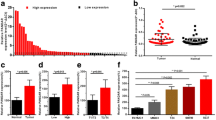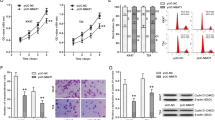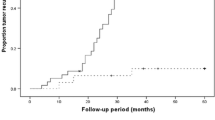Abstract
Long non-coding RNA TUG1 is involved in the development and progression of a variety of tumors. Little is known about TUG1 function in high-grade muscle-invasive bladder cancer (MIBC). The aims of our study were to determine expression levels of long non-coding RNA TUG1 in tumor tissue, to evaluate its relationship with clinico-pathological features of high-grade MIBC, and to describe its function in MIBC cells in vitro. TUG1 expression levels were determined in paired tumor and adjacent non-tumor bladder tissues of 47 patients with high-grade MIBC using real-time PCR. Cell line T-24 and siRNA silencing were used to study the TUG1 function in vitro. We observed significantly increased levels of TUG1 in tumor tissue in comparison to adjacent non-tumor bladder tissue (P < 0.0001). TUG1 levels were significantly increased in metastatic tumors (P = 0.0147) and were associated with shorter overall survival of MIBC patients (P = 0.0241). TUG1 silencing in vitro led to 34 % decrease in cancer cell proliferation (P = 0.0004) and 23 % reduction in migration capacity of cancer cells (P < 0.0001). We did not observe any significant effects of TUG1 silencing on cell cycle distribution and number of apoptotic cells. Our study confirmed overexpression of TUG1 in MIBC tumor tissue and described its association with worse overall survival in high-grade MIBC patients. Together with in vitro observations, these data suggest an oncogenic role of TUG1 and its potential usage as biomarker or therapeutic target in MIBC.


Similar content being viewed by others
References
Torre LA, Bray F, Siegel RL, Ferlay J, Lortet-Tieulent J, Jemal A. Global cancer statistics, 2012. CA Cancer J Clin. 2015;65:87–108.
Chavan S, Bray F, Lortet-Tieulent J, Goodman M, Jemal A. International variations in bladder cancer incidence and mortality. Eur Urol. 2014;66:59–73.
Apolo AB, Kim JW, Bochner BH, Steinberg SM, Bajorin DF, Kelly WK, et al. Examining the management of muscle-invasive bladder cancer by medical oncologists in the United States. Urol Oncol. 2014;32:637–44.
Burgess EF. Individualized management of advanced bladder cancer: where do we stand? Urol Oncol. 2015;33:187–95.
Sana J, Faltejskova P, Svoboda M, Slaby O. Novel classes of non-coding RNAs and cancer. J Transl Med. 2012;10:103.
Gutschner T, Diederichs S. The hallmarks of cancer: a long non-coding RNA point of view. RNA Biol. 2012;9:703–19.
Malek E, Jagannathan S, Driscoll JJ. Correlation of long non-coding RNA expression with metastasis, drug resistance and clinical outcome in cancer. Oncotarget. 2014;5:8027–38.
Mourtada-Maarabouni M, Pickard MR, Hedge VL, Farzaneh F, Williams GT. GAS5, a non-protein-coding RNA, controls apoptosis and is downregulated in breast cancer. Oncogene. 2009;28:195–208.
Yin DD, Liu ZJ, Zhang E, Kong R, Zhang ZH, Guo RH. Decreased expression of long noncoding RNA MEG3 affects cell proliferation and predicts a poor prognosis in patients with colorectal cancer. Tumour Biol. 2015;36:4851–9.
Gutschner T, Hammerle M, Eissmann M, Hsu J, Kim Y, Hung G, et al. The noncoding RNA MALAT1 is a critical regulator of the metastasis phenotype of lung cancer cells. Cancer Res. 2013;73:1180–9.
Gupta RA, Shah N, Wang KC, Kim J, Horlings HM, Wong DJ, et al. Long non-coding RNA HOTAIR reprograms chromatin state to promote cancer metastasis. Nature. 2010;464:1071–6.
Sidaway P. Prostate cancer: urinary PCA3 and TMPRSS2:ERG reduce the need for repeat biopsy. Nat Rev Urol. 2015;12:536.
Young TL, Matsuda T, Cepko CL. The noncoding RNA taurine upregulated gene 1 is required for differentiation of the murine retina. Curr Biol. 2005;15:501–12.
Zhang EB, Yin DD, Sun M, Kong R, Liu XH, You LH, et al. P53-regulated long non-coding RNA TUG1 affects cell proliferation in human non-small cell lung cancer, partly through epigenetically regulating HOXB7 expression. Cell Death Dis. 2014;5:e1243.
Sun J, Ding C, Yang Z, Liu T, Zhang X, Zhao C, et al. The long non-coding RNA TUG1 indicates a poor prognosis for colorectal cancer and promotes metastasis by affecting epithelial-mesenchymal transition. J Transl Med. 2016;14:42.
Xu Y, Wang J, Qiu M, Xu L, Li M, Jiang F, et al. Upregulation of the long noncoding RNA TUG1 promotes proliferation and migration of esophageal squamous cell carcinoma. Tumour Biol. 2015;36:1643–51.
Zhang E, He X, Yin D, Han L, Qiu M, Xu T, et al. Increased expression of long noncoding RNA TUG1 predicts a poor prognosis of gastric cancer and regulates cell proliferation by epigenetically silencing of p57. Cell Death Dis. 2016;7:e2109.
Huang MD, Chen WM, Qi FZ, Sun M, TP X, Ma P, et al. Long non-coding RNA TUG1 is up-regulated in hepatocellular carcinoma and promotes cell growth and apoptosis by epigenetically silencing of KLF2. Mol Cancer. 2015;14:165.
Zhang Q, Geng PL, Yin P, Wang XL, Jia JP, Yao J. Down-regulation of long non-coding RNA TUG1 inhibits osteosarcoma cell proliferation and promotes apoptosis. Asian Pac J Cancer Prev. 2013;14:2311–5.
Han Y, Liu Y, Gui Y, Cai Z. Long intergenic non-coding RNA TUG1 is overexpressed in urothelial carcinoma of the bladder. J Surg Oncol. 2013;107:555–9.
Tan J, Qiu K, Li M, Liang Y. Double-negative feedback loop between long non-coding RNA TUG1 and miR-145 promotes epithelial to mesenchymal transition and radioresistance in human bladder cancer cells. FEBS Lett. 2015;589:3175–81.
Acknowledgments
This work has been financially supported by the Czech Ministry of Health, grant no. 31071A, project MZ CR-RVO (MOU, 00209805) and the Ministry of Education, Youth and Sports of the Czech Republic under the project CEITEC 2020 (LQ1601). We would like to thank Jon B. Smith for proofreading the manuscript.
Author information
Authors and Affiliations
Corresponding authors
Ethics declarations
Conflicts of interest
None.
Rights and permissions
About this article
Cite this article
Iliev, R., Kleinova, R., Juracek, J. et al. Overexpression of long non-coding RNA TUG1 predicts poor prognosis and promotes cancer cell proliferation and migration in high-grade muscle-invasive bladder cancer. Tumor Biol. 37, 13385–13390 (2016). https://doi.org/10.1007/s13277-016-5177-9
Received:
Accepted:
Published:
Issue Date:
DOI: https://doi.org/10.1007/s13277-016-5177-9




